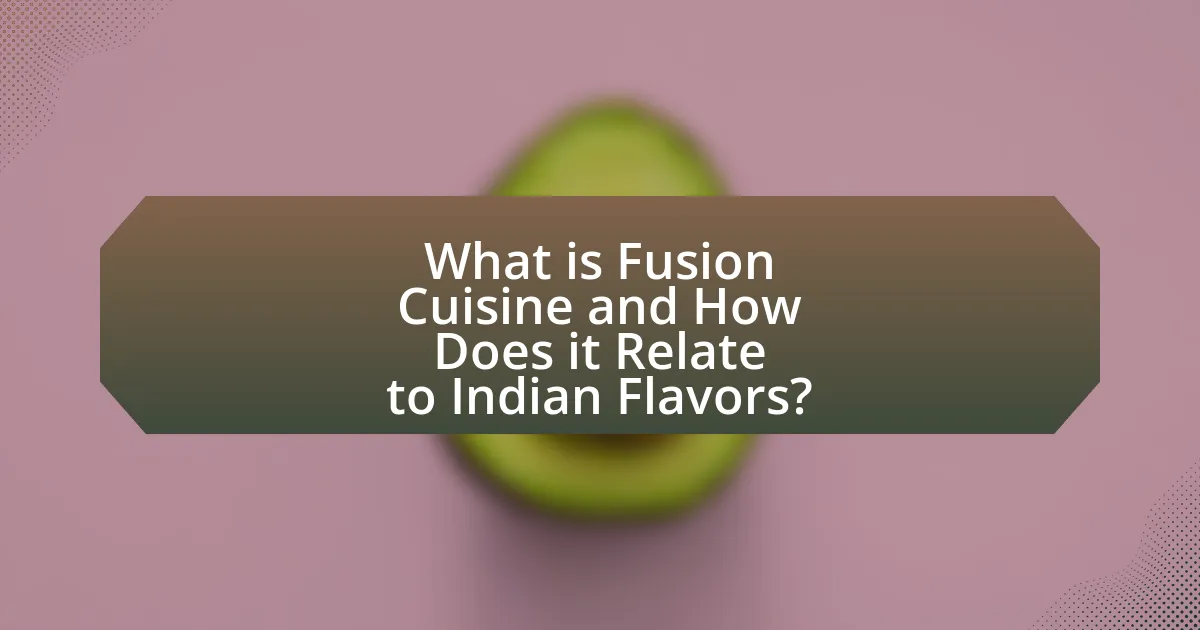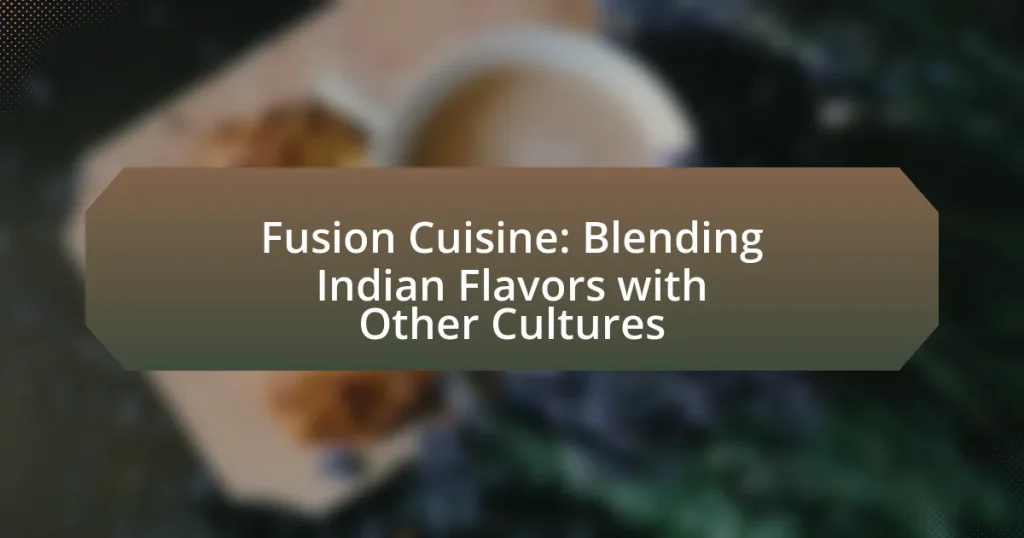Fusion cuisine is a culinary approach that merges elements from various culinary traditions, prominently featuring Indian flavors through the incorporation of traditional spices, cooking techniques, and ingredients. This article explores the definition of fusion cuisine within the context of Indian culinary traditions, highlighting historical influences, regional flavor contributions, and the impact of globalization on its popularity. It also examines how chefs innovate traditional Indian recipes, the challenges they face, and the perceptions of diners towards fusion dishes. Additionally, the article provides practical tips for home cooks to create Indian fusion dishes, emphasizing ingredient substitutions and simple recipes for beginners.

What is Fusion Cuisine and How Does it Relate to Indian Flavors?
Fusion cuisine is a culinary approach that combines elements from different culinary traditions to create innovative dishes. It relates to Indian flavors by incorporating traditional Indian spices, cooking techniques, and ingredients into various global cuisines, resulting in unique flavor profiles. For example, dishes like Indian-inspired tacos or curry-infused risottos showcase how Indian flavors can enhance and transform other culinary styles, reflecting the versatility and global appeal of Indian cuisine.
How is Fusion Cuisine Defined in the Context of Indian Culinary Traditions?
Fusion cuisine in the context of Indian culinary traditions is defined as the innovative blending of Indian cooking techniques and ingredients with those from other global cuisines. This culinary approach often results in unique dishes that maintain the essence of Indian flavors while incorporating elements from diverse culinary practices, such as the use of spices, cooking methods, and presentation styles from various cultures. For instance, dishes like tandoori chicken tacos or paneer quesadillas exemplify how Indian ingredients and flavors can be harmoniously integrated with Mexican cuisine, showcasing the adaptability and creativity inherent in fusion cuisine.
What are the Historical Influences on Indian Fusion Cuisine?
Historical influences on Indian fusion cuisine stem from various cultural interactions, including trade, colonization, and migration. The arrival of the Mughals in the 16th century introduced Persian and Central Asian culinary techniques, leading to dishes like biryani and kebabs. British colonization in the 19th century further blended Indian flavors with Western cooking styles, resulting in dishes such as curry served with chips. Additionally, the Indian diaspora has contributed to fusion cuisine by incorporating local ingredients and techniques from countries like the United States and Canada, creating unique dishes like tandoori chicken pizza. These historical interactions have shaped Indian fusion cuisine into a diverse and evolving culinary landscape.
How Do Regional Indian Flavors Contribute to Fusion Dishes?
Regional Indian flavors significantly enhance fusion dishes by introducing diverse spices, cooking techniques, and ingredient combinations that reflect India’s culinary heritage. For instance, the use of spices like cumin, coriander, and turmeric from North Indian cuisine can elevate a Western dish, such as roasted vegetables, by adding depth and complexity. Similarly, South Indian flavors, such as coconut and curry leaves, can transform a traditional pasta dish into a unique culinary experience. The integration of these regional elements not only creates innovative flavor profiles but also showcases the versatility of Indian cuisine, making it appealing to a global audience.
Why is Fusion Cuisine Popular in Today’s Culinary Scene?
Fusion cuisine is popular in today’s culinary scene because it combines diverse culinary traditions, creating innovative and unique flavor profiles that appeal to a broad audience. This popularity is driven by globalization, which has increased exposure to various cuisines, allowing chefs to experiment and blend ingredients and techniques from different cultures. For instance, the incorporation of Indian spices into traditional Western dishes has led to new culinary experiences, attracting food enthusiasts seeking novelty. Additionally, the rise of social media has amplified the visibility of fusion dishes, encouraging culinary creativity and experimentation among both professional chefs and home cooks.
What Role Does Globalization Play in the Rise of Fusion Cuisine?
Globalization significantly contributes to the rise of fusion cuisine by facilitating the exchange of culinary traditions and ingredients across cultures. This process allows chefs and home cooks to blend diverse cooking techniques and flavors, resulting in innovative dishes that reflect a global palate. For instance, the increasing availability of international ingredients in local markets enables the incorporation of spices and cooking methods from various cultures, such as Indian spices being used in traditional Western dishes. Additionally, the rise of travel and digital communication fosters cultural exchange, inspiring chefs to experiment with fusion concepts, as seen in the popularity of Indian-Mexican tacos or sushi burritos. This blending of culinary practices is a direct outcome of globalization, which breaks down barriers and encourages culinary creativity.
How Do Diners Perceive and Experience Fusion Cuisine?
Diners perceive and experience fusion cuisine as an innovative blend of diverse culinary traditions that enhances their dining experience. This perception is often characterized by excitement and curiosity, as diners seek unique flavors and combinations that challenge traditional culinary boundaries. Research indicates that fusion cuisine can evoke positive emotional responses, with diners appreciating the creativity and cultural exchange it represents. For instance, a study published in the Journal of Culinary Science & Technology highlights that 70% of participants expressed a preference for fusion dishes due to their novelty and the opportunity to explore different cultural flavors in a single meal.

What Are Some Examples of Indian Fusion Dishes?
Some examples of Indian fusion dishes include Tandoori Chicken Tacos, Butter Chicken Pizza, and Masala Quesadilla. Tandoori Chicken Tacos combine traditional Indian marinated chicken with Mexican-style tortillas, showcasing a blend of spices and cooking techniques. Butter Chicken Pizza merges the rich, creamy flavors of butter chicken with a classic Italian pizza base, appealing to diverse palates. Masala Quesadilla features Indian spices and ingredients within a Mexican quesadilla, creating a unique culinary experience. These dishes exemplify the innovative blending of Indian flavors with other cultural cuisines.
How Do Indian Flavors Blend with Other Culinary Traditions?
Indian flavors blend with other culinary traditions through the use of spices, cooking techniques, and ingredient combinations that enhance and complement diverse cuisines. For example, Indian spices like cumin, coriander, and turmeric are often incorporated into dishes from regions such as Southeast Asia and the Middle East, creating unique fusion dishes like Indian-inspired tacos or curry-infused sushi. This blending is supported by the historical movement of Indian diaspora, which has led to the adaptation of Indian flavors in various global cuisines, resulting in popular dishes like butter chicken poutine in Canada or masala chai lattes in Western coffee culture. The adaptability of Indian flavors allows for innovative culinary creations that respect and celebrate both Indian and local traditions.
What Are Notable Indian Fusion Dishes from Different Cultures?
Notable Indian fusion dishes from different cultures include Tandoori Pizza, which combines traditional Indian tandoori cooking with Italian pizza, and Butter Chicken Burrito, merging Indian butter chicken with Mexican burrito elements. These dishes exemplify the blending of flavors and techniques, showcasing how Indian spices and cooking methods can enhance global cuisines. For instance, Tandoori Pizza often features a naan base topped with tandoori chicken, mozzarella cheese, and a variety of vegetables, reflecting both Indian and Italian culinary traditions. Similarly, the Butter Chicken Burrito wraps spiced chicken in a tortilla, illustrating the adaptability of Indian flavors in a Mexican context.
How Do Ingredients from Other Cultures Enhance Indian Dishes?
Ingredients from other cultures enhance Indian dishes by introducing diverse flavors, textures, and cooking techniques that elevate traditional recipes. For instance, the use of Italian herbs like basil and oregano in Indian pasta dishes creates a unique fusion that appeals to a broader palate. Additionally, the incorporation of Middle Eastern spices such as za’atar and sumac adds complexity and depth to Indian curries, enriching the overall dining experience. Historical trade routes have facilitated the exchange of ingredients, leading to innovations like the use of tomatoes and potatoes, which are now staples in Indian cuisine but originated from the Americas. This blending not only reflects cultural exchange but also showcases the adaptability of Indian cooking, making it more versatile and globally appealing.
What Techniques Are Used in Creating Indian Fusion Cuisine?
Indian fusion cuisine employs techniques such as ingredient substitution, cross-cultural cooking methods, and flavor pairing to create innovative dishes. Ingredient substitution involves replacing traditional Indian components with those from other culinary traditions, such as using quinoa instead of rice. Cross-cultural cooking methods may include grilling or sautéing, which are common in Western cuisines, applied to Indian spices and ingredients. Flavor pairing focuses on combining Indian spices with non-Indian ingredients, like using curry in pasta sauces or tacos, enhancing the overall taste profile. These techniques reflect the adaptability and creativity inherent in fusion cuisine, allowing for a harmonious blend of diverse culinary influences.
How Do Chefs Innovate Traditional Indian Recipes for Fusion Cuisine?
Chefs innovate traditional Indian recipes for fusion cuisine by incorporating ingredients, techniques, and flavors from other culinary traditions. This approach often involves blending spices and cooking methods from Indian cuisine with elements from global cuisines, such as using Italian pasta in a curry or incorporating Mexican spices into a biryani. For example, chefs may create dishes like tandoori chicken tacos or paneer quesadillas, which showcase the versatility of Indian flavors while appealing to diverse palates. This innovation not only enhances the dining experience but also reflects the growing trend of culinary experimentation and globalization in the food industry.
What Cooking Methods Are Common in Indian Fusion Dishes?
Common cooking methods in Indian fusion dishes include grilling, sautéing, and baking. Grilling is often used to enhance the flavors of marinated meats and vegetables, incorporating traditional Indian spices with techniques from other cuisines. Sautéing allows for quick cooking while blending Indian ingredients with global flavors, creating dishes like stir-fried noodles with Indian spices. Baking is utilized in fusion desserts, where Indian sweets are combined with Western baking techniques, such as in the creation of cardamom-infused cakes. These methods reflect the adaptability of Indian cuisine in merging with diverse culinary traditions.

What Challenges Do Chefs Face When Creating Indian Fusion Cuisine?
Chefs face several challenges when creating Indian fusion cuisine, primarily related to balancing authentic flavors with innovative techniques. The complexity of Indian spices and cooking methods can clash with the culinary traditions of other cultures, leading to potential misinterpretations of both cuisines. Additionally, chefs must navigate ingredient availability, as some traditional Indian components may not be easily accessible in regions where fusion cuisine is popular. This can limit the authenticity of the dishes. Furthermore, there is a risk of alienating purists from both culinary backgrounds, as fusion dishes may be criticized for not adhering strictly to traditional recipes. These challenges require chefs to possess a deep understanding of both Indian cuisine and the other culinary traditions they are blending, ensuring that the final product respects the essence of each while creating a harmonious new dish.
How Do Cultural Sensitivities Impact Fusion Cuisine Development?
Cultural sensitivities significantly impact fusion cuisine development by influencing ingredient choices, preparation methods, and presentation styles to respect diverse culinary traditions. For instance, when blending Indian flavors with other cultures, chefs must consider dietary restrictions, such as vegetarianism in Hindu culture or halal requirements in Muslim communities, ensuring that the fusion dishes are acceptable and appealing to those audiences. Additionally, cultural sensitivities guide the narrative and context in which the cuisine is presented, as misrepresentation or appropriation can lead to backlash and alienation of cultural groups. This is evident in the rise of culinary movements that prioritize authenticity and respect, such as the “slow food” movement, which emphasizes local ingredients and traditional cooking methods, thereby fostering a more inclusive approach to fusion cuisine.
What Are Common Misconceptions About Indian Fusion Cuisine?
Common misconceptions about Indian fusion cuisine include the belief that it lacks authenticity and is merely a trend. In reality, Indian fusion cuisine combines traditional Indian flavors with elements from other culinary traditions, creating innovative dishes that respect both origins. Additionally, some people think that fusion cuisine dilutes the essence of Indian cooking; however, many chefs aim to enhance and celebrate the diverse ingredients and techniques found in Indian cuisine while incorporating global influences. This approach has historical roots, as Indian cuisine has always evolved through interactions with various cultures, making fusion a natural extension of its culinary heritage.
How Can Chefs Maintain Authenticity While Innovating?
Chefs can maintain authenticity while innovating by deeply understanding traditional techniques and ingredients, ensuring that any new creations respect the original cultural context. This involves studying the history and significance of the dishes they aim to blend, allowing chefs to incorporate innovative elements without losing the essence of the cuisine. For instance, chefs who fuse Indian flavors with other cultures often utilize traditional spices and cooking methods, adapting them thoughtfully to new culinary landscapes. This approach not only honors the original cuisine but also enriches the dining experience, as seen in successful fusion restaurants that highlight the integrity of both culinary traditions.
What Tips Can Help Home Cooks Create Indian Fusion Dishes?
Home cooks can create Indian fusion dishes by experimenting with traditional Indian spices and ingredients while incorporating elements from other cuisines. For instance, using garam masala in a pasta sauce or adding curry powder to a taco filling can enhance flavors and create unique dishes. Additionally, understanding the cooking techniques of both Indian and the other cuisine can lead to innovative combinations, such as grilling marinated paneer for a Mediterranean-style wrap. The versatility of Indian cuisine allows for a wide range of adaptations, making it easier to blend with various culinary traditions.
How Can Ingredients Be Substituted for Fusion Cooking at Home?
Ingredients for fusion cooking at home can be substituted by identifying equivalent flavors and textures from different cuisines. For example, if a recipe calls for paneer, tofu can be used as a dairy-free alternative that mimics the texture. Similarly, coconut milk can replace cream in Indian dishes to create a lighter, vegan option while maintaining creaminess. Herbs and spices can also be interchanged; for instance, cilantro can substitute for parsley to add a fresh note. These substitutions allow for the blending of Indian flavors with other culinary traditions, enhancing the overall dish while accommodating dietary preferences.
What Are Some Simple Indian Fusion Recipes for Beginners?
Some simple Indian fusion recipes for beginners include Tandoori Chicken Tacos, Paneer Quesadillas, and Masala Pasta. Tandoori Chicken Tacos combine marinated tandoori chicken with traditional taco ingredients like lettuce and salsa, creating a flavorful dish that merges Indian and Mexican cuisines. Paneer Quesadillas feature Indian paneer cheese and spices, sandwiched between tortillas, offering a quick and satisfying meal. Masala Pasta incorporates Indian spices into classic pasta dishes, making it a versatile option for those looking to blend flavors. These recipes are straightforward and require minimal cooking skills, making them ideal for beginners.
